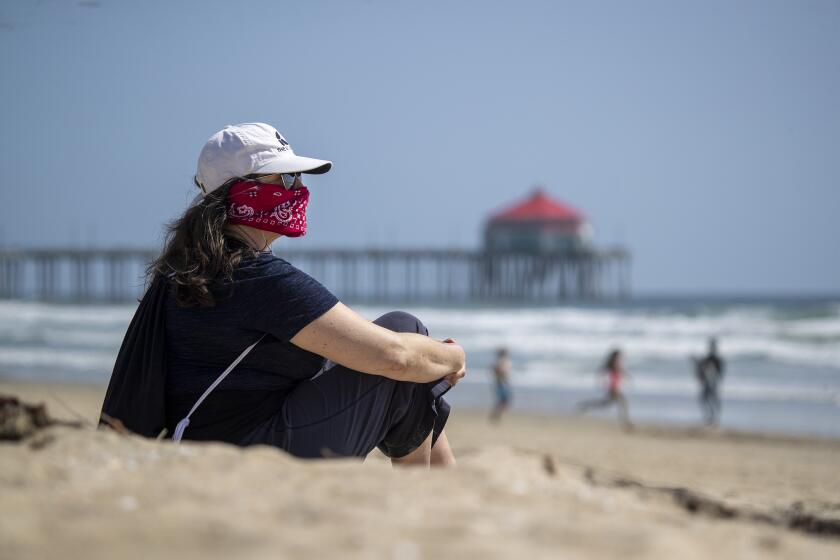In the Pipeline: A sign of the (bygone) times
While I was driving down Bushard Street in Fountain Valley recently, just after crossing Talbert Avenue, something caught my eye near the Taco Bell parking lot — a small, square-shaped green sign fixed to a metal post.
What drew my attention were the words atop the sign, “Blacksmith Shop.” I pulled over to check it out and, to my pleasant surprise, discovered that the sign was a historic designation (my favorite kind of sign) indicating that, “In 1898, John Corbett opened a blacksmith shop here. It was later purchased by Charles Archer. Two other shops were located nearby.”
A logo on the sign seemed to indicate that it had been placed during Fountain Valley’s 50th anniversary celebration back in 2007.
Then, gazing across the street, I noticed another green sign. And another. Further down the block, yet another. It seemed the history of the intersection of Talbert and Bushard had been completely documented with these signs, and so I set off to read them.
Within just a few minutes, I’d learned about the Escalante Circus, which each year would erect its tent on the site, marking the point where the circus parade would begin. I stood at the site where, in 1899, a post office was established, and next to it, between 1896 and 1898, a country store owned by Tom Talbert (Talbert, as you may know, was one of Orange County’s most prominent citizens — in addition to being a farmer and working in real estate, he also served as mayor of Huntington Beach).
I crossed Bushard where another sign was located, to find that I was now standing where an elementary school had once stood in the early 1900s, replaced by a building in 1920 that wound up serving as city hall from 1962-64.
All of a sudden, the intersection of Talbert and Bushard took on a new life. Standing there, I could imagine how it may have looked, felt and sounded 100 years ago. And this was exciting.
Looking down Bushard, I thought I saw a few more signs on the next block, so I wandered off. I was rewarded with a green sign marking the site of the “Talbert Home,” where “Sam and Hattie came here in 1897. He built a river levee and huge ditches so that the land would drain to permit regular farming.”
Almost directly opposite the street, the former site of a “Buddhist Church.” As the sign described, the church had been built in 1935, dedicated in 1936, and was the first Buddhist church in Orange County. In 1954, the church moved to Stanton, then moved to Anaheim in 1965.
On a small plot of land near the church site, stalks of corn have been planted, providing a bit of connection to the area’s past life as a center of agriculture. But the signs themselves helped connect the historic dots in the most remarkable way for me.
When I got home, I wrote my friend Dan Gibb, a local historian who authored a book on the history of Fountain Valley, put out by Arcadia Publishing, to ask him about the signs. He told me that one of the Fountain Valley Historical Society’s board members, Blanche Weaver, had them placed in honor of the city’s anniversary.
And what a wonderful thing that she did. For years, I’ve been an advocate of this sort of signing program in Huntington Beach. Yes, there are several markers on Main Street that indicate what used to stand on certain sites. The Huntington Beach Historic Resources Board recently released an interesting new brochure titled “A Walking Tour of Historic Downtown Huntington Beach.”
But beyond downtown, how nice would it be to have markers like this throughout the city limits — where the old tile and broom factories used to stand, or the Holly Sugar Plant?
There are potentially dozens of noteworthy sites that, if marked like this, could help us develop a deeper appreciation for Huntington Beach and remind people of the city’s rich historic layers. The farms, schools, churches and homes that the city grew from all hold marvelous stories, and even if they are gone, when we mark the site, we remind people that the ground is still hallowed.
We let next generations know that something occurred there, something worth learning about.
CHRIS EPTING is the author of 18 books, including the new “Hello, It’s Me: Dispatches from a Pop Culture Junkie.” You can chat with him on Twitter @chrisepting or follow his column at https://www.facebook.com/hbindependent.
All the latest on Orange County from Orange County.
Get our free TimesOC newsletter.
You may occasionally receive promotional content from the Daily Pilot.



